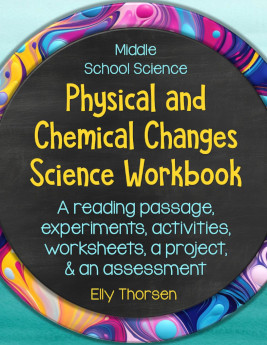Elly Thorsen has created two science workbooks about physical and chemical changes that offer homeschooled students in middle school a change of pace from traditional textbooks. The two workbooks are Changes in States of Matter Physical Science Workbook and Physical and Chemical Changes Science Workbook.
Each workbook is about 50 pages in length and should take 10 sessions to complete. While the workbooks say they are not to be reproduced, Thorsen tells me that parents can make copies of the consumable pages to use within their families.
You might use one or both books in a concentrated fashion, spending two weeks per book, or spread the lessons out for fewer days per week over several weeks. They will be only one component of your science curriculum, possibly serving as a unit study.
These paperback books are printed in black and white, but they should appeal visually to students because of the occasional cartoon illustrations, playful fonts that are relatively large, and plentiful graphics. In addition, Thorsen presents concepts in a relatable manner, frequently using experiences familiar to students to illustrate processes like the chemical changes of a rotting banana or the condensation visible on a fogged-over mirror.
The feature that I find most attractive is the way Thorsen combines reading, writing, drawing, and hands-on activities to keep students interested. Both books are arranged similarly—frontloaded with a few pages of information to read, which is then supported by worksheets, graphic organizers, activities, and projects. Students fill in information and drawings on the graphic organizers. On some pages, they answer questions with one or more sentences. In addition, they complete a critical thinking activity page, a card-sorting activity, and a poster project. Changes in States of Matter adds a comic project while Physical and Chemical Changes adds simple experiments. Each book includes one or two “demonstration” experiments that need to be led by an adult.
If you follow the suggested schedule at the front of each book, the hands-on activities and experiments are intermixed with written work after the first session. Concepts are continually reviewed and expanded upon. For instance, the card sorting activity in Changes in States of Matter has students begin by matching definition cards with cards naming six physical processes: condensation, deposition, freezing, melting, sublimation, and vaporization. (They will have already learned what these words mean in an early lesson.) Next, they match six cards that visually model the six processes. Finally, they categorize 12 cards under the six categories. Six more cards are provided for students to create their own examples. A graphic organizer provided for this activity has students record their answers (the selected cards) in writing. Then it has two questions for them to answer with at least a few sentences. Students can check the answer key at the back of the book to make sure they have sorted correctly before recording their answers. This card-sorting activity ties everything students have learned in the workbook lessons in a multi-sensory manner that feels like a game yet includes reading and writing.
Both books include a one-page test as well as a creative form of assessment using question cards (in one of three suggested ways). Once past the initial instruction, parents can choose which activities, worksheets, and assessments to use, so there’s some flexibility.
While parents need to be involved with some activities, students can complete many on their own. A complete answer key is provided at the back of each book, making it easy for parents with a weak background in science to easily evaluate student responses.
I suggest starting with Changes in States of Matter before Physical and Chemical Changes since the first book builds a foundational knowledge of physical changes that is expanded upon in the second book.
Note that similar resources are available on Thorsen’s TeachersPayTeachers webpage, but these two workbooks have been adapted particularly for use by homeschoolers and should be their most practical option.
Summary
I’ve seen many homeschooling families get bogged down toward the end of each semester, and resources like these physical science workbooks can be great for a change of pace—a break from what you’ve been doing without making a drastic change in your curriculum.











